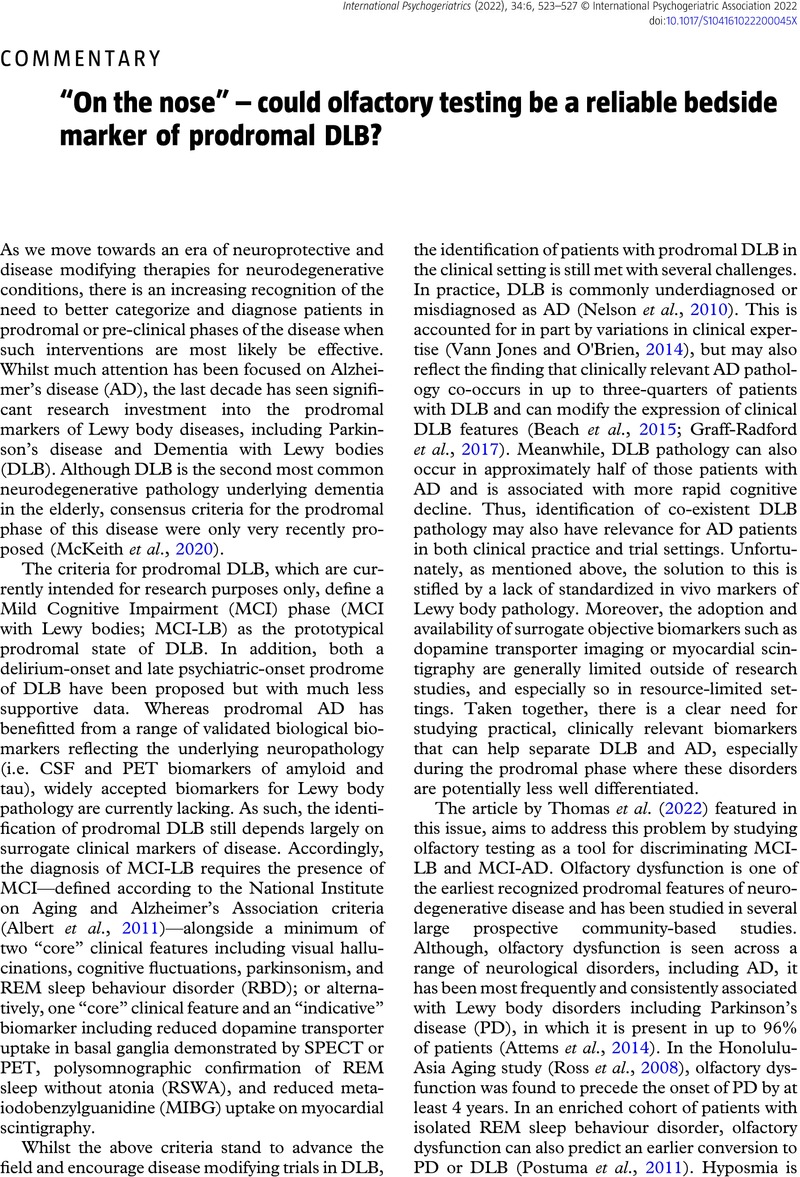No CrossRef data available.
Article contents
“On the nose” – could olfactory testing be a reliable bedside marker of prodromal DLB?
Published online by Cambridge University Press: 05 May 2022
Abstract
An abstract is not available for this content so a preview has been provided. Please use the Get access link above for information on how to access this content.

- Type
- Commentary
- Information
- International Psychogeriatrics , Volume 34 , Special Issue 6: Issue Theme: New Studies of Mild Cognitive Impairment , June 2022 , pp. 523 - 527
- Copyright
- © International Psychogeriatric Association 2022
References
Albert, M. S. et al. (2011). The diagnosis of mild cognitive impairment due to Alzheimer’s disease: recommendations from the National Institute on Aging-Alzheimer’s Association workgroups on diagnostic guidelines for Alzheimer’s disease. Alzheimer’s & Dementia, 7, 270–279.10.1016/j.jalz.2011.03.008CrossRefGoogle Scholar
Attems, J., Walker, L. and Jellinger, K. A. (2014). Olfactory bulb involvement in neurodegenerative diseases. Acta Neuropathologica, 127, 459–475.10.1007/s00401-014-1261-7CrossRefGoogle ScholarPubMed
Bahar-Fuchs, A., Moss, S., Rowe, C. and Savage, G. (2011). Awareness of olfactory deficits in healthy aging, amnestic mild cognitive impairment and Alzheimer’s disease. International Psychogeriatrics, 23, 1097–1106.10.1017/S1041610210002371CrossRefGoogle ScholarPubMed
Beach, T. G. et al. (2015). Arizona study of aging and neurodegenerative disorders and brain and body donation program. Neuropathology, 35, 354–389.10.1111/neup.12189CrossRefGoogle ScholarPubMed
Beach, T. G. et al. (2020). Severe hyposmia distinguishes neuropathologically confirmed dementia with Lewy bodies from Alzheimer’s disease dementia. PLoS One, 15, e0231720.10.1371/journal.pone.0231720CrossRefGoogle ScholarPubMed
Berg, D. et al. (2015). MDS research criteria for prodromal Parkinson’s disease. Movement Disorders, 30, 1600–1611.10.1002/mds.26431CrossRefGoogle ScholarPubMed
Boeve, B. F. et al. (2016). Arguing against the proposed definition changes of PD. Movement Disorders, 31, 1619–1622.10.1002/mds.26721CrossRefGoogle ScholarPubMed
Borghammer, P. et al. (2021). Neuropathological evidence of body-first vs. brain-first Lewy body disease. Neurobiology of Disease, 161, 105557.10.1016/j.nbd.2021.105557CrossRefGoogle ScholarPubMed
Borghammer, P. and Van Den Berge, N. (2019). Brain-first versus gut-first Parkinson’s disease: a hypothesis. Journal of Parkinson’s Disease, 9, S281–s295.10.3233/JPD-191721CrossRefGoogle Scholar
Braak, H., Del Tredici, K., Rub, U., de Vos, R. A., Jansen Steur, E. N. and Braak, E. (2003). Staging of brain pathology related to sporadic Parkinson’s disease. Neurobiology of Aging, 24, 197–211.10.1016/S0197-4580(02)00065-9CrossRefGoogle ScholarPubMed
Brundin, P. and Melki, R. (2017). Prying into the prion hypothesis for Parkinson’s disease. Journal of Neuroscience, 37, 9808–9818.10.1523/JNEUROSCI.1788-16.2017CrossRefGoogle ScholarPubMed
Doty, R. L., Shaman, P. and Dann, M. (1984). Development of the University of Pennsylvania smell identification test: a standardized microencapsulated test of olfactory function. Physiology & Behavior, 32, 489–502.10.1016/0031-9384(84)90269-5CrossRefGoogle Scholar
Ferreira, D. et al. (2020). β-Amyloid and tau biomarkers and clinical phenotype in dementia with Lewy bodies. Neurology, 95, e3257–e3268.10.1212/WNL.0000000000010943CrossRefGoogle ScholarPubMed
Graff-Radford, J. et al. (2017). Duration and pathologic correlates of Lewy body disease. JAMA Neurology, 74, 310–315.10.1001/jamaneurol.2016.4926CrossRefGoogle ScholarPubMed
Hawkes, C. H., Del Tredici, K. and Braak, H. (2007). Parkinson’s disease: a dual-hit hypothesis. Neuropathology and Applied Neurobiology, 33, 599–614.10.1111/j.1365-2990.2007.00874.xCrossRefGoogle ScholarPubMed
Hummel, T., Sekinger, B., Wolf, S. R., Pauli, E. and Kobal, G. (1997). ’Sniffin' sticks': olfactory performance assessed by the combined testing of odor identification, odor discrimination and olfactory threshold. Chemical Senses, 22, 39–52.10.1093/chemse/22.1.39CrossRefGoogle ScholarPubMed
Mahlknecht, P. et al. (2016). Optimizing odor identification testing as quick and accurate diagnostic tool for Parkinson’s disease. Movement Disorders, 31, 1408–1413.10.1002/mds.26637CrossRefGoogle ScholarPubMed
McKeith, I. et al. (2007). Sensitivity and specificity of dopamine transporter imaging with 123I-FP-CIT SPECT in dementia with lewy bodies: a phase III, multicentre study. The Lancet Neurology, 6, 305–313.10.1016/S1474-4422(07)70057-1CrossRefGoogle ScholarPubMed
McKeith, I. G. et al. (2020). Research criteria for the diagnosis of prodromal dementia with Lewy bodies. Neurology, 94, 743–755.10.1212/WNL.0000000000009323CrossRefGoogle Scholar
Nelson, P. T. et al. (2010). Low sensitivity in clinical diagnoses of dementia with Lewy bodies. Journal of Neurology, 257, 359–366.10.1007/s00415-009-5324-yCrossRefGoogle ScholarPubMed
Postuma, R. B. et al. (2015). MDS clinical diagnostic criteria for Parkinson’s disease. Movement Disorders, 30, 1591–1601.10.1002/mds.26424CrossRefGoogle ScholarPubMed
Postuma, R. B., Gagnon, J. F., Vendette, M., Desjardins, C. and Montplaisir, J. Y. (2011). Olfaction and color vision identify impending neurodegeneration in rapid eye movement sleep behavior disorder. Annals of Neurology, 69, 811–818.10.1002/ana.22282CrossRefGoogle ScholarPubMed
Ross, G. W. et al. (2008). Association of olfactory dysfunction with risk for future Parkinson’s disease. Annals of Neurology, 63, 167–173.10.1002/ana.21291CrossRefGoogle ScholarPubMed
Tahmasebi, R., Zehetmayer, S., Pusswald, G., Kovacs, G., Stögmann, E. and Lehrner, J. (2019). Identification of odors, faces, cities and naming of objects in patients with subjective cognitive decline, mild cognitive impairment and Alzheimer’s disease: a longitudinal study. International Psychogeriatrics, 31, 537–549.10.1017/S1041610218001114CrossRefGoogle ScholarPubMed
Thomas, A. J. et al. (2022). Olfactory impairment in mild cognitive impairment with Lewy bodies and Alzheimer’s disease. International Psychogeriatrics, 34, 585–592. https://doi.org/10.1017/S1041610221001265.Google Scholar
Vann Jones, S. A. and O'Brien, J. T. (2014). The prevalence and incidence of dementia with Lewy bodies: a systematic review of population and clinical studies. Psychological Medicine, 44, 673–683.10.1017/S0033291713000494CrossRefGoogle ScholarPubMed
Velayudhan, L., Pritchard, M., Powell, J. F., Proitsi, P. and Lovestone, S. (2013). Smell identification function as a severity and progression marker in Alzheimer’s disease. International Psychogeriatrics, 25, 1157–1166.10.1017/S1041610213000446CrossRefGoogle ScholarPubMed
Velayudhan, L., Wilson-Morkeh, F., Penney, E., Jesu, A. J. M., Baillon, S. and Brugha, T. (2019). Smell identification function in early-onset Alzheimer’s disease and mild cognitive impairment. International Psychogeriatrics, 31, 1065–1070.10.1017/S1041610218001503CrossRefGoogle ScholarPubMed
Yoo, H. S. et al. (2018). Olfactory dysfunction in Alzheimer’s disease- and Lewy body-related cognitive impairment. Alzheimer’s & Dementia, 14, 1243–1252.10.1016/j.jalz.2018.05.010CrossRefGoogle ScholarPubMed




